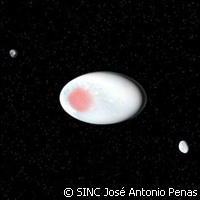Crystalline ice covers dwarf-planet Haumea
New findings from the European Southern Observatory's Very Large Telescope (VLT) in Chile have shown that the fifth dwarf planet of the Solar System, Haumea, is covered in crystalline water-ice which makes it shine in the darkness of space. Haumea, which was discovered in 2005, is a small and mysterious planet that moves beyond the orbit of Neptune. It is shaped like a flattened rugby ball and is approximately 2,000 km long. It can spin once around its axis in less than four hours and has one of the fastest rotation speeds in the Solar System. One of five dwarf planets in the Solar System alongside Pluto, Haumea was named after the goddess of fertility and birth from Hawaiian mythology. An international team of researchers from Chile, France and Spain studied the dwarf planet: they confirm that 75?% of Haumea and 100?% of Hi'iaka, one of Haumea's satellites which is around 400 km in diameter, are covered with crystallised water-ice (with an ordered structure) and not, as would have been expected, with amorphous ice disorganised due to solar radiation. The results, published in the journal Astronomy and Astrophysics, suggest that the planet is made up of a frozen outer layer, and an internal section made up of between 88?% and 97?% rock. 'Since solar radiation constantly destroys the crystalline structure of ice on the surface, energy sources are required to keep it organised. The two that we have taken into consideration are able to generate radiogenic elements (potassium-40, thorium-232 and uranium-238) from the inside, and the tidal forces between Haumea and its satellites (as seen between the Earth and the Moon),' says Benoit Carry, co-author of the study and a researcher at the ESAC Centre of the European Space Agency (ESA) in Madrid, Spain. Benoit Carry also underlines some of the other peculiarities of Haumea: 'Its orbital plane is inclined at 28º with respect to the usual plane of planets in the Solar System, the orbits of its satellites are not on the same plane either - which is very unusual - and the entire system belongs to a single family within the frozen objects in the Kuiper Belt (at a distance of between 4.5 billion and more than 15 billion kilometres from the Sun).' According to the scientists, the two satellites could have been created by another object smashing into Haumea, and the impact of this smash could also have given Haumea its rugby-ball shape. Benoit Carry also explains how observations from the Spectrograph for Integral Field Observations in the Near Infrared (SINFONI) instrument of the VLT were essential for carrying out this study: 'SINFONI is an integral field spectrometer that provides 'data cubes' in which two of the dimensions are spatial (like those of any flat image), while the third is spectral, meaning that each layer of the cube is an image taken with a different wave size.' The precise orbits and sizes of the dwarf planet are still not known, nor are those of its satellites. In reality, these are two very distant bright points of light, the data for which are obtained indirectly. In the case of the tiny Namaka (around 200 km in diameter), the signal at the time it was observed was so weak that it was impossible to obtain information about its surface, although new data on its orbit were gathered. Meanwhile, the models for the tidal forces of this strange system are also improving. Another one of Haumea's mysteries is the presence of a dark-reddish spot, which contrasts with the whitish colour of the planet. 'My interpretation of the infrared photometry is that this area could be a richer source of crystalline water-ice than the rest of the surface,' says Pedro Lacerda, co-discoverer of the spot and an astronomer at Queen's University in Belfast, United Kingdom.For more information, please visit:European Southern Observatory (ESO):http://www.eso.org/public/
Countries
Chile, Spain, France



